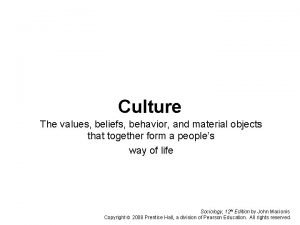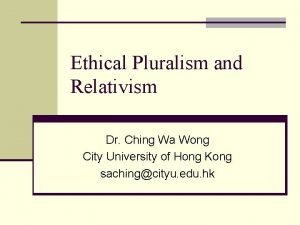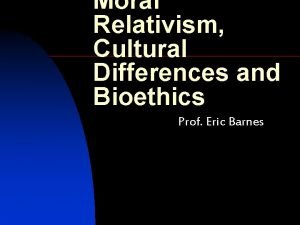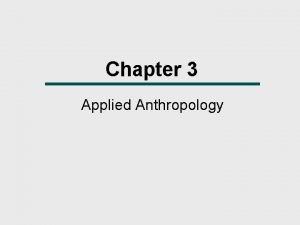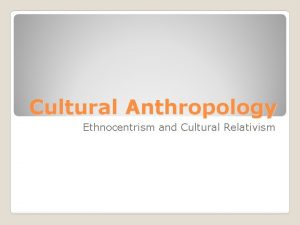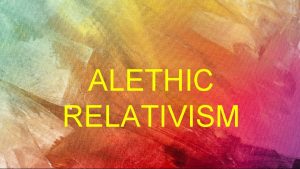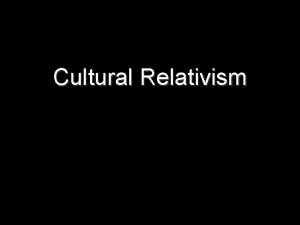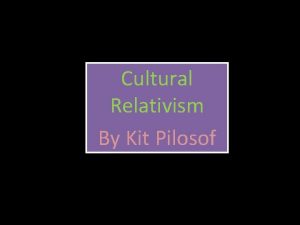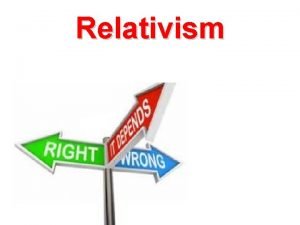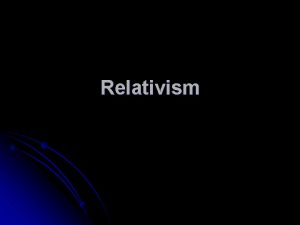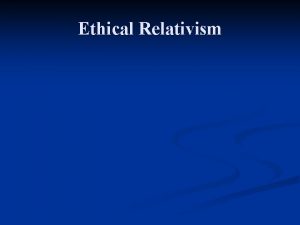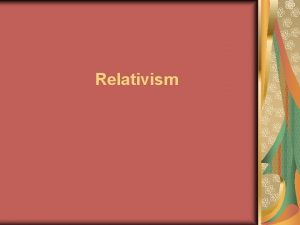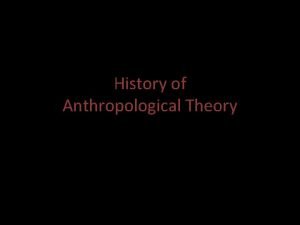Cultural relativism Cultural relativism is the anthropological principle









- Slides: 9

Cultural relativism

Cultural relativism is the anthropological principle stating that a person’s beliefs and activities must be understood in the local context of that person’s own culture. In 1887, Franz Boas first articulated this principle as: “. . . civilization is not something absolute, but. . . is relative, and. . . our ideas and conceptions are true only so far as our civilization goes”, whereby, he established an axiom of anthropological research.

Philospohically, cultural relativism originated in the German Enlightenment, when Immanuel Kant postulated that human beings are incapable of direct, unmediated knowledge of the world — that all experience of it is mediated by the mind, which universally structures experience according to the person’s perception of time and space.

As a methodological and heuristic method � Cultural relativism was partly a response to Western ethnocentrism, i. e. the conscious belief that Western arts are the most beautiful, its values the most virtuous, and its beliefs the most truthful. Originally trained as a physicist and as a geographer, and intellectually much influenced by Kant, Herder, and von Humboldt, Franz Boas argued that one’s culture might mediate — and thus limit — objective perception of other cultures. His understanding of “culture” as comprehending given tastes in food, art, music, and religious belief, presumed a wider definition of culture as: the totality of the mental and physical reactions and activities that characterize the behavior of the individuals composing a social group collectively and individually in relation to their natural environment, to other groups, to members of the group itself, and of each individual to himself.

As methodological analysis � Between the First and Second world wars, cultural relativism was the principal analytic method for U. S. anthropologists confronting the refusal of non-Western peoples to accept the West’s claim for the universality of its culture, and in salvaging non-Western cultures. That refusal transformed Boas’s epistemology into methodological lessons. � Language is the most obvious case; although commonly perceived as a means of communication, Boas understood language as also a means of categorizing experience of the world, therefore, the existence of different languages indicates that people categorize and experience language differently, (a perspective that the Sapir. Whorf hypothesis develops more fully). Although people perceive light as the visible spectrum (color continuum), their different languages name its colors with different words. To wit, some languages have no native word corresponding to the English word “green”, hence, when non-English speakers see a green-color chip, they might identify it with their word for “blue”, and others with their word for “yellow”.

As methodological analysis �Melville Herskovits, a Boas alumnus, summarised cultural relativism thus: “Judgements are based on experience, and experience is interpreted by each individual in terms of his own enculturation. ” �To objectively study and understand other cultures, Boas and alumnæ understood they would need to employ research methods allowing their escape from ethnocentric limitation. One such method is ethnography: living with the people of the culture being studied for an extended period, and learning their language to become partly enculturated. In that context, cultural relativism is an intellectual attitude of fundamental methodologic importance, because it underscores the importance of local context to comprehending the meaning of particular cultural beliefs and activities.

As a heuristic method � Another method is ethnology: the systematic, even-handed comparison and contrasting of as wide as possible a range of cultures. In the late nineteenth century, such study was primarily effected via cultural artefact diplays. Typically, museum curators assumed that like causes produce like effects; therefore, to understand the causes of human activities, they grouped like artefacts together — regardless of provenance — into families, genera, and species, as in biology; thus organized, museums displayed the forms of civilisational evolution from the crude to the refined. It is only since the development of the evolutional theory that it became clear that the object of study is the individual, not abstractions from the individual under observation. We have to study each ethnological specimen individually in its history and in its medium. . By regarding a single implement outside of its surroundings, outside of other inventions of the people to whom it belongs, and outside of other phenomena affecting that people and its productions, we cannot understand its meanings. . Our objection. . . is, that classification is not explanation.

As a critical method � Marcus and Fischer’s underscoring anthropology’s denying the claim to universality of Western culture implies that cultural relativism is an analytical method useful for cultural understanding and for cultural critique. It indicates anthropology’s second aspect of enlightenment: The other promise of anthropology, one less fully distinguished and attended to than the first, has been to serve as a form of cultural critique for ourselves. In using portraits of other cultural patterns to reflect self-critically on our own ways, anthropology disrupts common sense and makes us reexamine our taken-for-granted assumptions. [9] About the critical function of cultural relativism, the philosopher John Cook said, “It is aimed at getting people to admit that although it may seem to them that their moral principles are self-evidently true, and hence seem to be grounds for passing judgement on other peoples, in fact, the self-evidence of these principles is a kind of illusion”. [10] Despite misconstruing cultural relativism as identical to moral relativism, Cook’s observation applies to the broader definition of the term — meaning not that one’s cultural principles are false, but that claiming them as “self-evident” is false.

The Statement on Human Rights � In 1947, cultural relativism metamorphosed into moral relativism during the composition of the Universal Declaration of Human Rightsby the U. N. ’s. Commission of Human Rightsrelativism � The problem is thus to formulate a statement of human rights that will do more than phrase respect for the individual as individual. It must also take into full account the individual as a member of a social group of which he is part, whose sanctioned modes of life shape his behavior, and with whose fate his own is thus inextricably bound. The gist is that the Universal Declaration of Human Rights was primarily prepared by Western societies, and expresses Western values that are not universal: Today the problem is complicated by the fact that the Declaration must be of world-wide applicability. It must embrace and recognize the validity of many different ways of life. It will not be convincing to the Indonesian, the African, the Chinese, if it lies on the same plane as like documents of an earlier period. The rights of Man in the Twentieth Century cannot be circumscribed by the standards of any single culture, or be dictated by the aspirations of any single people. Such a document will lead to frustration, not realization of the personalities of vast numbers of human beings. Despite possible interpretation as making a mere procedural point — that the Commission of Human Rights must include non-Western peoples — especially from the cultures that had been or that remained imperially subjugated by Europe, the Statement on Human Rights concludes with two, substantive claims: Even where political systems exist that deny citizens the right of participation in their government, or seek to conquer weaker peoples, underlying cultural values may be called on to bring the peoples of such states to a realization of the consequences of the acts of their governments, and thus enforce a brake upon discrimination and conquest. World-wide standards of freedom and justice, based on the principle that man is free only when he lives as his society defines freedom, that his rights are those he recognizes as a member of his society, must be basic.


